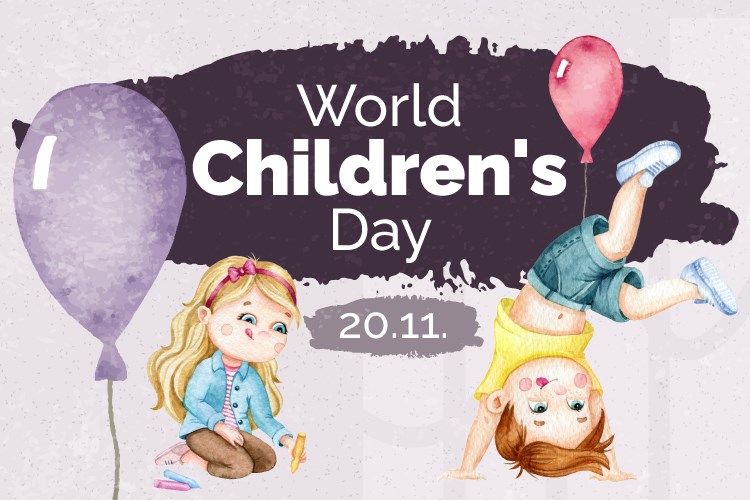- Published: 17.11.2023.
From the cradle to adulthood, everything is monitored by statistics
Marking World Children’s Day
They want to be grown up, and the grown ups would like to, even for a moment, be little ones again. While children want to grow up and become adults as soon as possible, adults remember their childhood and carefree days of playing and discovering the world with nostalgia. Although teenagers may take offence at this definition, the Convention on the Rights of the Child considers every human being younger than 18 years of age to be a child. According to the mid-2022 population estimate, the share of children, that is, persons younger than 18, in Croatia was 17.3%.Check out the rest of the "children’s" statistics, which we explored on the occasion of the World Children’ Day, celebrated on 20 November, in the text below.
More boys than girls are born, and most children are born in the summer - what else do demographic data say?
Last year, there were 33 883 live births in Croatia, of which there were slightly more boys (50.9%) than girls (49.1%). The largest number of children were born in summer, more precisely in July (3 063), and the lowest in April (2 533). Although the birth of every child is a great joy for their parents and family, in some cases, the happiness is doubled or even tripled. In 2022, a total of 1 120 twins were born and 31 children were triplets (or multiple children were born in the same birth). Almost all children, 99.9% of them, were born in a health care institution. Three quarters of the children, or 75.2% of them, were born in marriage, and 24.8% of the children were born out of wedlock.
The live birth rate, defined as the number of live births per 1 000 inhabitants, was 8.8.
At the national level, the number of live births is decreasing year by year. There are towns and municipalities that had a positive natural increase in 2022, that is, they had more live births than deaths.
According to the Census, in 2021 there were a total of 394 134 families in Croatia that had at least one child younger than 18. Of that, almost half of the families had one child younger than 18, more precisely 194 137 of them, while 10 758 families had four or more children younger than 18.
Other data can be found in the graph below.
How many kindergartens and how many schools? Do children and young people go to the theatre?
Education plays a big role in growing up. It starts with pre-school education, which was attended by 147 888 children at the beginning of the 2022/2023 pedagogic year. They had 1 583 kindergartens at their disposal, of which 1 195 were state-owned, 330 were private and 58 were religious ones, as well as 144 other legal entities, that is, basic schools, playrooms in libraries or other institutions and organisations implementing preschool education programmes.
According to age, 22.0% of children were up to three years old, 37.4% were between three and five years old, while the largest share of children (40.6%) were between five and seven years old or older. Regular programme was attended by 135 252 children and pre-school programme by 8 487 children, while a shorter programme was attended by 4 149 children.
The following step, of course, is basic education. At the beginning of the 2022/2023 school year, there were a total of 2 065 basic schools, which were attended by 305 602 pupils. They were taught by 36 533 teachers. However, it would be more accurate to say that this was the number of teacher jobs. Due to the multiple reporting of persons working part-time, a full-time equivalent is applied for accurate reporting of the number of teachers. At the beginning of the 2022/2023 school year, there were 31 153.6 teachers in basic schools in full-time equivalent.
At the beginning of the last school year, there were 743 active upper secondary schools, which were attended by 147 126 students. A total of 19 152.1 teachers worked in upper secondary schools in full-time equivalent.
Check out the graph below to see the distribution of children in education by sex.
We were often told in childhood that school comes first, then playtime. However, there are some activities that bring together both. In the 2021/2022 season, a total of 5 205 children’s plays and puppet shows were played in theatres, which were attended live by almost half a million visitors.
Each pupil and student is a mandatory member of a school library, so the fact that the members of libraries in basic and secondary schools accounted for 41% of all library memberships in 2022 is no surprise. However, even outside the book report and schoolwork obligations, judging by the statistical data of public libraries, children and young people like to read. In 2022, the share of members under the age of 18 in the total number of public library members was 42%. At the same time, as much as 65% of the total number of visitors who attended library events and workshops were under the age of 18.
Use the World Children's Day as an occasion for family time in a theatre or at a workshop. And a message for you adults, regardless of the age limit, is to always keep your inner child alive! And at the same time, take care of the youngest members of our society.
